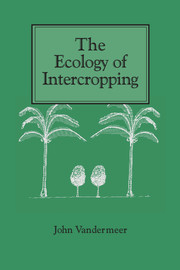Book contents
- Frontmatter
- Contents
- Preface
- 1 Introduction: intercrops and ecology
- 2 The measurement of intercrop performance
- 3 The competitive production principle
- 4 Facilitation
- 5 Mechanisms of the competitive production principle
- 6 The environments modified to produce facilitation
- 7 Special problems in intercrops involving perennials
- 8 Weeds and intercrops
- 9 Variability and intercrops
- 10 Planning intercrops – a phenomenological approach
- 11 Planning intercrops – a mechanistic approach
- 12 Critical research directions for the future
- References
- Author index
- Subject index
5 - Mechanisms of the competitive production principle
Published online by Cambridge University Press: 05 August 2012
- Frontmatter
- Contents
- Preface
- 1 Introduction: intercrops and ecology
- 2 The measurement of intercrop performance
- 3 The competitive production principle
- 4 Facilitation
- 5 Mechanisms of the competitive production principle
- 6 The environments modified to produce facilitation
- 7 Special problems in intercrops involving perennials
- 8 Weeds and intercrops
- 9 Variability and intercrops
- 10 Planning intercrops – a phenomenological approach
- 11 Planning intercrops – a mechanistic approach
- 12 Critical research directions for the future
- References
- Author index
- Subject index
Summary
The competitive production principle, as elucidated in Chapter 3, in a sense needs no further explanation or mechanism to explain intercrop advantage. It is just the case that the intercrop system is advantageous over its monocultural alternatives if competition between the two crops is not very intense. But it nevertheless makes sense to ask, at a more mechanistic level, what is the mechanism whereby competition is rendered small. This is a common question in community ecology, where one uses phrases like ‘niche subdivision’, ‘habitat partitioning’, ‘niche overlap’, ‘resource partitioning (or overlap or subdivision)’, and probably others to refer to the same set of phenomena. When two species are obviously doing more or less the same thing in an environment, as described in Chapter 3, it is natural to expect one or the other to dominate, much as competition in sports results in a winner and loser. As we now know, stalemate in nature is as common as checkmate. When expectations of a winner and loser are assumed because of obvious similarities in the two species, but they nevertheless coexist in the same environment, it is most natural to ask why. Why is the expected extinction of one of the species not observed? Formally the question is usually posed as ‘what is the mechanism of coexistence?’
Given the formal similarity between the competitive exclusion principle and the competitive production principle, it makes sense to ask ‘what is the mechanism of intercrop advantage?’ even if it is known that the advantage stems only from the weakness of the competitive interaction.
- Type
- Chapter
- Information
- The Ecology of Intercropping , pp. 68 - 85Publisher: Cambridge University PressPrint publication year: 1989
- 1
- Cited by



